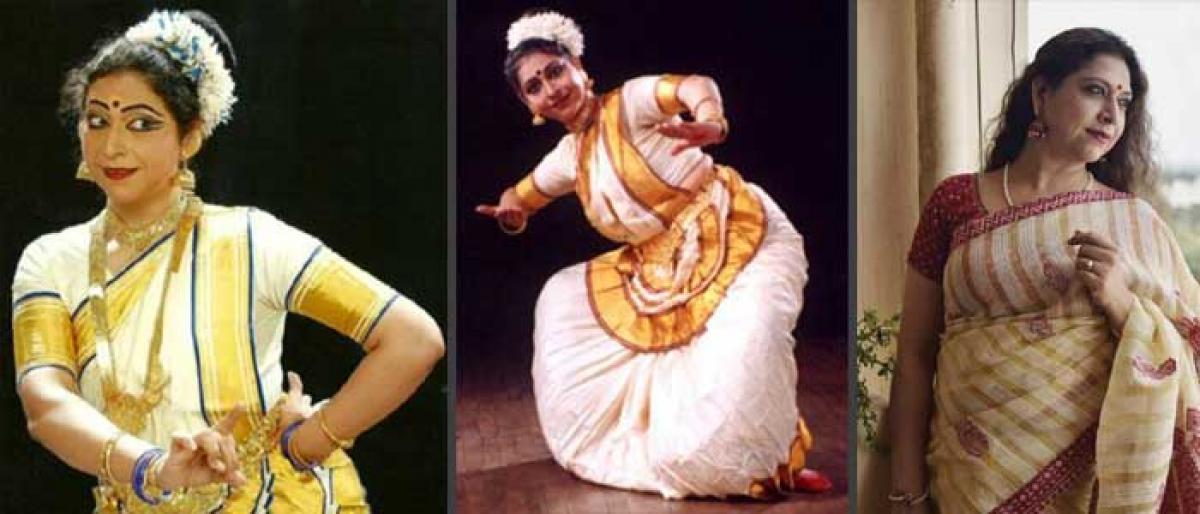Live
- Ajit Pawar elected as leader of NCP in Maha Assembly
- Love, murder, cover-up: Married man kills live-in partner, sets body on fire
- Kishida launches new group within ruling LDP: Report
- Shreya Ghoshal to perform in 'Tripura Tourism Promo Fest'
- Congress lost its stature as brand, now just a regional party: Kangana
- Abu Dhabi T10: New York Strikers reflect on dominant bowling display in win over Bangla Tigers
- VHP Karnataka Resolves to Oppose Alleged Land Encroachments Under Wakf Board
- Formula 1: Verstappen claims fourth drivers' title as Russell leads Mercedes 1-2 in Las Vegas
- Air quality in Kolkata, Howrah deteriorates
- IPL 2025 Auction: Aim is to make Punjab Kings one of the powerhouses, says head coach Ricky Ponting
Just In

Mohiniyattam dancer Mom Ganguly from Kolkata showcased important elements of Tulsidas Ramayana in a multi-dance production ‘Ballads of Rama’ along with popular bhajan singer Anup Jalota at Hyderabad recently. In an exclusive interview, she spoke about this new creative production and the present situation of classical art.
Mohiniyattam dancer Mom Ganguly from Kolkata showcased important elements of Tulsidas Ramayana in a multi-dance production ‘Ballads of Rama’ along with popular bhajan singer Anup Jalota at Hyderabad recently. In an exclusive interview, she spoke about this new creative production and the present situation of classical art.
What does Ramayana mean to you and why the thought of this production?
We are also losing out in knowing about our culture and epics. The teenagers are seeing animated versions of Ramayana and other international television serials. In my younger days, even I have studied the Ramayana. In the past, there used to be joint families and children used to get to know about such epics through their grandparents. It’s all gone with more nuclear families coming to the fore. And who else would be a better choice than well-known singer Anup Jalota, to give a voice for the dance production. He has been popularising the Tulsikrit Ramcharitmanas since a very long time. It’s taken more than two years to conceptualise and make this production possible. For me, Ramayana is something that is all about the contemporary society. Lord Rama has a message of peace and is an epitome of leadership.
What’s unique about this dance production?
The unique aspect of this production is that the character of Hanuman has been portrayed in Kathakali dance style while that of Ravana and Rakshasas in the powerful Mayurbhanj Chau dance style. I have taken up the role of Lord Rama in Mohiniyattam style. So it’s an amalgamation of different styles which more or less goes with the thought process of characters.
How do you see the presence of Mohiniyattam in India?
The presence of Mohiniyattam is growing in the country. It’s the only classical dance form of Kerala. I am sure this production will take it far. Mohiniyattam is a meditative art form. It is an internalised dance form. It’s a link between body, mind and limbs. There is a need to understand the intricacies and have a deeper understanding of the subject. We find a good number of young entrants showing up to learn the form.
How do you see the position of artistes in present society?
I feel that artistes should get more respect and social security in their quest for art. We spend time and money on our passion for life. But artistes are looked down and questioned about what else they do in life other than pursuing their art. Even for small things like block-booking of railway tickets, we do not have any facility which is available for sports persons. I think even artistes deserve some higher percentage of interest on fixed deposits made with banks as in the case of senior citizens. Art is a lifestyle and full time work. Everything costs, right from costume, music recording, co-artiste remuneration. There is, therefore, a big need for support from the government also in terms of social security schemes and production grants. Everyone needs to survive. General music and art forms are suffering. There are hardly any housing schemes for artistes. Money spent on culture can build a great society. We must have a vibrant national policy on culture.
Are you happy with the role of the corporate sector that supports art through the Corporate Social Responsibility wing?
As far as the Corporate Social Responsibility (CSR) is concerned, more often multi-national companies prefer to sponsor programmes that have a foreign connection/collaboration rather than a pure Indian culture based programme.
Why is interest waning in classical arts?
It is very important for parents to groom the children and see that they understand the importance of Indian culture. I think there needs to be atmosphere at home. We also need to create ‘Rasikas’ from an age group of 10 years to 25 years. We need to remove the concept that classical art is for the class audience only and not the masses. Maybe we need to add some dynamic factors to the traditional art without diluting the art form. This might always retain an interest in classical arts among the young generation.
Presentations of all art forms need to be in sync with the modern times. There is enough scope for creativity.

© 2024 Hyderabad Media House Limited/The Hans India. All rights reserved. Powered by hocalwire.com







